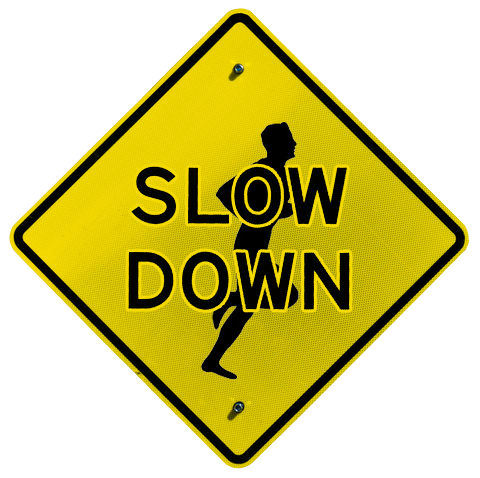If I could give one piece of advice to beginner and experienced runners, it is to: Slow down, you’ll get faster.
It sounds counter-intuitive, but I have seen more benefit from running slow miles than pushing the pace every run. I used to try and go fast all of the time, thinking I would gradually get faster each time. In reality, I was shortening the fuse on an injury-bomb just waiting to go off. It happened with my calf injury several years ago. I know exactly where, when, and why it tore. I was pushing the pace to run with a buddy. I felt a twinge in my calf. But instead of backing off, I continued on and it felt like a sniper had shot my leg. That set me back several months.
Beyond injury prevention, slower miles build your aerobic system, increasing the amount of oxygen you can have available in your blood for use by your muscles. When those oxygen levels deplete, you fatigue. I found this quote from Jeff Gaudette of Runners Connect to be very interesting:
“Aerobic development is roughly the same whether you’re running at 30 seconds or 2 minutes slower than marathon pace. For a 3:30 marathoner, this means that 8:30 pace provides basically the same aerobic benefits as miles at 9:30 or 10:00 pace. However, running faster than 8:30 pace only increases the time it takes for you to recover while providing little additional benefit aerobically. So, running faster is actually detrimental.
Running faster on your easy days is not important and it is not necessarily a sign of increasing fitness. Focus instead on the purpose of easy runs – recovering from hard workouts and preparing the body for upcoming sessions. When you stop thinking about pace and start concentrating on recovering, you’ll be able to relax more and enjoy your easy runs for what they are – recovery.”
My marathon pace is around 6:45-7:00 per mile. I consider my easy pace to be around 8:20-9:00 per mile. This easy pace is referred to by many coaches as conversation pace. The pace at which you can carry a conversation without being too out of breath to make sentences. An excerpt from the RRCA Coaching Manual defines the benefits of conversation pace running:
“Conversational pace running benefits:
Trains the cardio-respiratory system and muscular system to efficiently absorb, deliver, and utilize oxygen while removing waste products, such as carbon dioxide, lactic acid and so forth.
At a cellular level, increases the quantity and size of mitochondria, improving the muscle’s ability to receive and process oxygen and conserve stores of glycogen.”
Below is a very good article from Men’s Journal by Lisa Marshall. It talks about using an 80/20 ratio of low and high intensity workouts.
http://www.mensjournal.com/health-fitness/exercise/80-20-training-run-slower-get-faster-20140923
“High-intensity workouts recruit fast-twitch muscle fibers that provide extra power late into a race or game. They also boost blood vessel elasticity, build a stronger heart, and up pain tolerance. All that time in the slow zone, meanwhile, primes your muscles to be able to crush the high-intensity sessions. During tough bouts, your fast-twitch muscles rapidly burn through glucose for fuel, which creates metabolic by-products like lactate and hydrogen ions that — if not cleared from the muscles — inhibit muscle contraction and the breakdown of food for fuel. The result? You slow down. The slow-twitch muscles are responsible for recycling that otherwise toxic lactate back into energy, enabling you to stay on pace. Low-intensity training also revs the growth of mitochondria, which helps the body burn fat efficiently and fends off soreness and fatigue.”
If you are training for a race, your main goal should be to hit the start line in your best physical shape possible. Pushing the intensity for too long in your training puts you in risk of injury. Use the lower intensity periods as recovery time. You are basically building a more fuel efficient running machine by running at slower paces.


